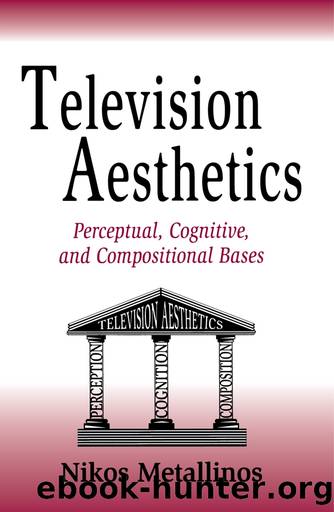Television Aesthetics by Nikos Metallinos

Author:Nikos Metallinos [Metallinos, Nikos]
Language: eng
Format: epub
Tags: Social Science, Media Studies
ISBN: 9781136686146
Google: 3l_-AQAAQBAJ
Publisher: Routledge
Published: 2013-11-05T05:53:48+00:00
The Categories of the Arts
The vast development of the arts of Western civilization during the last 3,000 years makes the classification of the arts very difficult. Political movements, religious beliefs, scientific discoveries, traveling explorations, industrial developments, and information communication technology explosions have caused the development of a vast number of art forms that are as difficult to categorize as they are to define. Furthermore, the art classification task becomes even more difficult today due to the rapid developments of media technologies. This section provides a broad classification of the arts, distinguishes the various forms of popular arts, and briefly examines the visual communication media arts, specifically the various television genres.
A Broad Classification of the Arts. The discussion of the characteristics of the arts suggest that an art form is characterized by a threefold process: the act of creating the art form, the art of presenting it, and the art of responding to it. Although in some art forms like painting, theater, and music, this process can occur simultaneously, there are nevertheless three distinct stages that must be taken and three different agents involved in this process: the artist(s), the medium, and the receiver(s). Furthermore, it was stated that to consider an event or an object significantly artistic it must surpass the ordinary and provide uniqueness and significance in its message (content), in its medium (form), and for its audience (impact). Equally important (before any general classification of the arts is made), is to discuss their various functions, whether they are communicative, utilitarian, social, psychological, and so on.
On the basis of these parameters the arts fall into two major categories: fine arts and applied arts. Whereas fine arts such as architecture, painting, sculpture, poetry, music, theater, photography, and film have been defined as art created primarily as an aesthetic expression to be contemplated and enjoyed for its own sake, applied art such as decorative designs of manufactured items, advertising, commercial art, and plastic art is defined as utilitarian. It is used as an instrument for other activities (such as decoration), which remain subservient to the function of the objects, media, and events they promote. All popular commercial and industrial arts are applied arts. The significance of the applied artistâs version is limited to the media, the product, or the industrial needs it encompasses. Fine arts, on the other hand, are broader in the intellectual, emotional, and aesthetic scopes extending their significance to all three areas: their message, medium, and recipients.
It is, of course, obvious that the distinction between fine arts and applied arts remains a line that is difficult to draw. There are some applied art objects or events that occasionally meet the requirements of the fine arts and vice versa; the fine arts appeal to a small and elite public, whereas the applied arts appeal to a large, broader, and more general public.
The Popular Arts. The advent of mass media (or media of mass communication) such as newspapers, magazines, comic books, radio, and television created the phenomenon of a mass
Download
This site does not store any files on its server. We only index and link to content provided by other sites. Please contact the content providers to delete copyright contents if any and email us, we'll remove relevant links or contents immediately.
| Coloring Books for Grown-Ups | Humor |
| Movies | Performing Arts |
| Pop Culture | Puzzles & Games |
| Radio | Sheet Music & Scores |
| Television | Trivia & Fun Facts |
Robin by Dave Itzkoff(2303)
Head of Drama by Sydney Newman(2234)
I'm Judging You by Luvvie Ajayi(2131)
The Paranormal 13 (13 free books featuring witches, vampires, werewolves, mermaids, psychics, Loki, time travel and more!) by unknow(2031)
Ten by Gretchen McNeil(1804)
Single State of Mind by Andi Dorfman(1743)
#MurderTrending by Gretchen McNeil(1592)
Key to the Sacred Pattern: The Untold Story of Rennes-le-Chateau by Henry Lincoln(1577)
Merv by Merv Griffin(1540)
Most Talkative by Andy Cohen(1523)
This Is Just My Face by Gabourey Sidibe(1407)
Notes from the Upside Down by Guy Adams(1396)
The Hunger Games: Official Illustrated Movie Companion by Egan Kate(1367)
Springfield Confidential by Mike Reiss(1340)
Jamie Oliver by Stafford Hildred(1336)
Clarkson--Look Who's Back by Gwen Russell(1284)
Binging with Babish by Andrew Rea(1278)
The TV Writer's Workbook: A Creative Approach To Television Scripts by Ellen Sandler(1276)
Blue Planet II by James Honeyborne & Mark Brownlow(1215)
